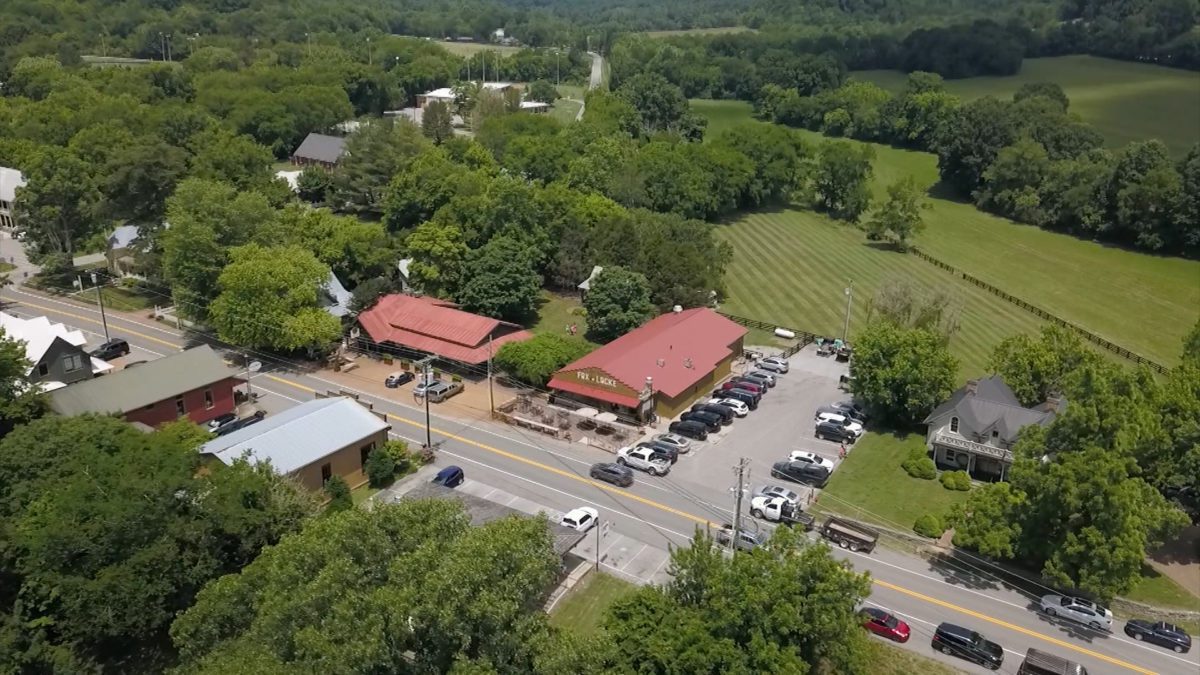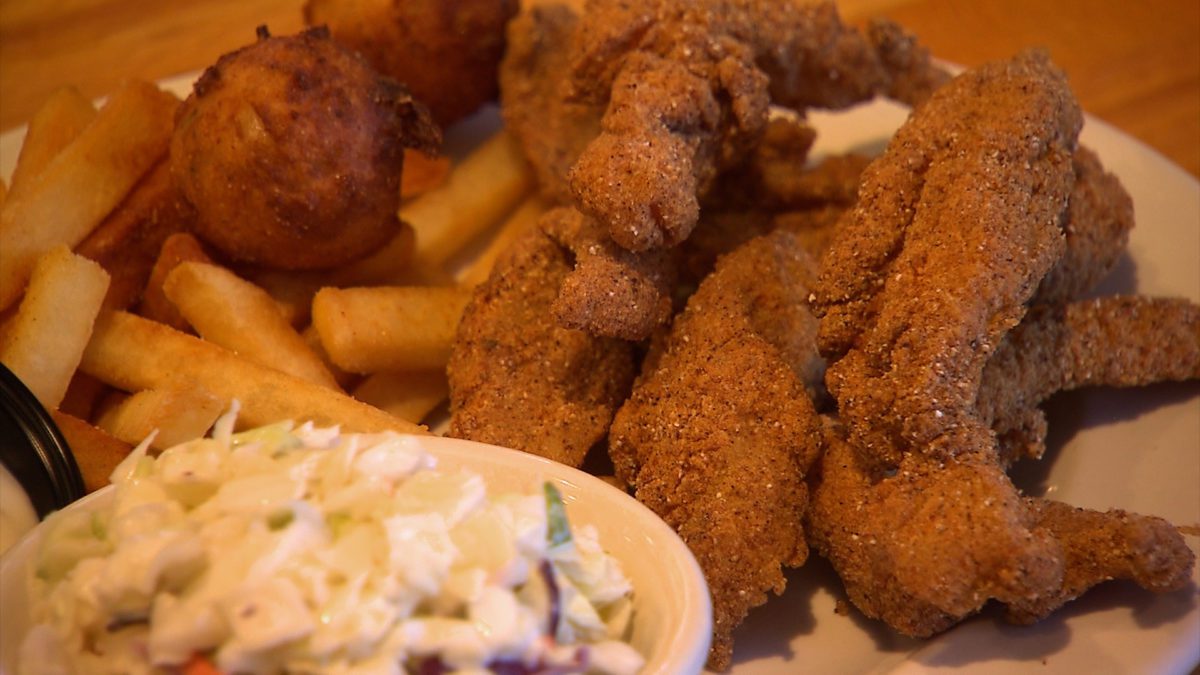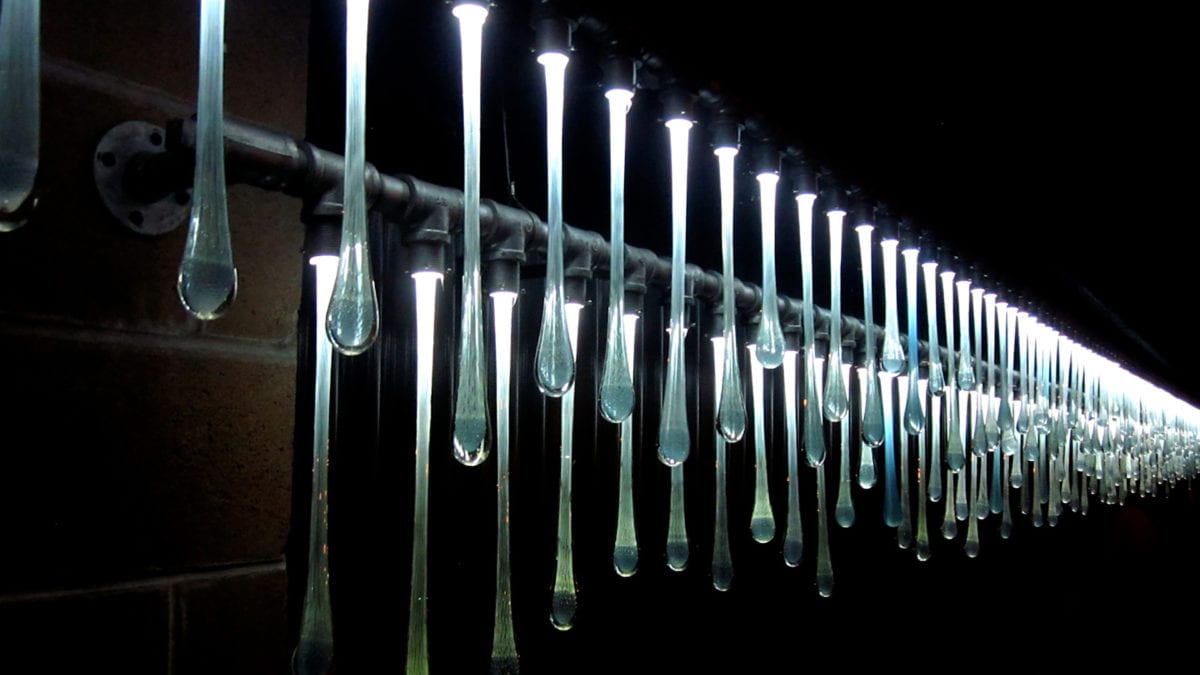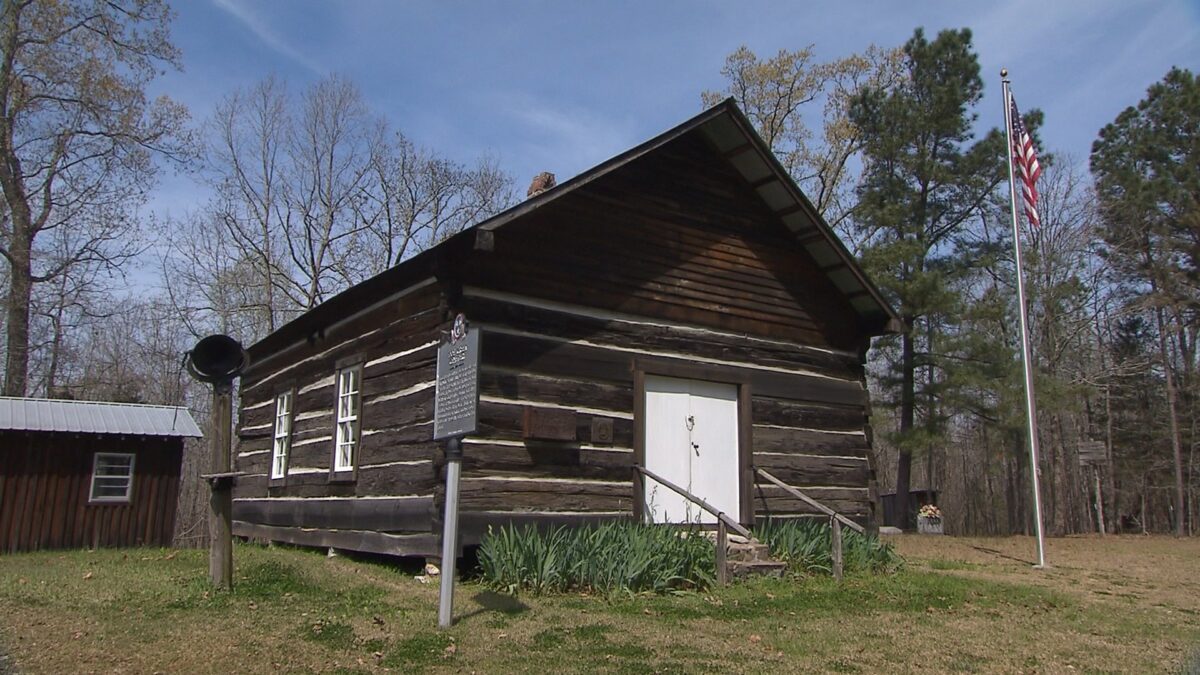Episode 3615
Don't have the PBS App? Click Here
Episode Transcript
- [Announcer] Tennessee Crossroads is made possible in part by: - [Announcer] You can't predict the future, but you can count on Tennessee Tech always putting students first. Our faculty, staff and students have shown strength, compassion, patience and kindness during these trying times. For us, it's personal. That's what you can count on at Tennessee Tech. - [Joe Elmore] This time on Tennessee Crossroads, we make a road trip to a popular family diner in Hohenwald. Then explore Leiper's Fork in Williamson County. We'll discover the works of a Joelton Glassblower and visit a restored relic from the past, a one-room schoolhouse. Hi folks, I'm Joe Elmore. Welcome again to Tennessee Crossroads. Sure good to have you. Fall is a great time of year to take a scenic Tennessee road trip. Maybe to quaint little town with a big surprise when it comes to local dining. We found such a town and local diner recently, when we made a road trip to Lewis County. With a population of just under 4,000, Hohenwald is the county seat of Lewis County. Highway 412 runs through its quaint, peaceful downtown. Now, you might not think of Hohenwald as a destination, unless you're among those who've discovered Hank's Family Diner. Hank's has a 50s diner feel and a fun family friendly ambience. The daytime menu features everything from breakfast and brunch, to burgers and wraps. Plus the ever popular catfish on Fridays. Desserts? Oh yeah, but more about that later. - [Paula Sims] It's kind of off the beaten path, over here. Like if you don't know we're here, you drive right by, On 412 'cause you, it's kind of on one of these little side streets. I've been shocked at how far we've had people come. Who have seen it on Facebook, seen it on Instagram seen it on some other website. - [Joe Elmore] That's Paula Sims, she's a Hohenwald native who spent many years in the food industry as an employee. Then in 2019 the previous owner convinced her to buy the place. - So I rolled the dice and lo and behold a couple weeks later I walked into my first day here. Then five months later, Covid walked in. - [Joe Elmore] Oh boy. - So, but I, I'm glad I did it. It's been a journey, as much as I thought I knew in all my years in food and beverage, it's completely different when it's yours. - [Joe Elmore] Paula's recipe for success is pretty simple. A super friendly staff that shares her vision and of course a consistently quality product that brings folks back for more. - [Paula Sims] I had to invest my money in my product to make it worthwhile. My mama taught us growing up that people eat with their eyes before they ever eat with their mouth. If you make it pretty and it tastes good, it gets you far. It needs to be something they wanna take a picture of when we set it down in front of them. - [Joe Elmore] Friday's fish is always picture perfect. Starting with fresh catfish, dipped in a special batter for extra flavor. - [Paula Sims] I can't tell you what's in our breading, but we do pond-raised catfish filets every Friday, and I usually will sell two or three cases of it on Friday. - [Joe Elmore] Hank's Diner has a well earned reputation for irresistible desserts. Especially ice cream treats, whether it's on top of a brownie or part of a banana split or inside one of the diners now legendary milkshakes. - [Paula Sims] Well base flavors right now, we've got vanilla, strawberry, mint chocolate chip, we can do peach, we can do malt flavors and then we kind of just take that base and I let these girls just get as creative as they want to get, with toppings. - [Joe Elmore] The "Crazy Shake", as it's called, never fails to amaze customers of all ages. Well, this happy young lady may need some help with hers. By the way the Diner's history goes back to the early 1930s. That's when the original owner Mac Floyd and his brother first sold burgers out of this location. At the present site, some employees are a little skittish about visiting the upstairs stock room. For a somewhat spooky reason. - [Paula Sims] They say Mr. Floyd is still in the building. It's flipping a quarter who has to go upstairs and get stocked 'cause they don't wanna go. I've made a pact with him, as long as he doesn't bother me, I'm not gonna bother him. - [Joe Elmore] Don't expect any ghost sightings on your visit here. Just a friendly serving of good food and perhaps a good reason to take a scenic road trip to Hohenwald. Well next we head to a little hamlet in Williamson County with a big reputation. Leiper's Fork in some ways seems to be frozen in time and as Cindy Carter discovered the local inhabitants are working pretty hard to keep it that way. - [Cindy Carter] In the heart of Tennessee's Williamson County, amid the rolling landscape of green pastures, forests and the rambling Harpeth River, you'll find a small village smack dab in the middle of beautiful nowhere. Where music plays, ♪ It's only in Nashville that your doors always open ♪ and art inspires. - Hello there. - Hi! - How's everybody doing? Come on in. - [Cindy Carter] And Southern charm is also on full display. - It's a way of life, it's very community oriented. It's a place where everybody knows everybody. - [Cindy Carter] Leiper's Fork has always been a special place for the farmers, merchants and other folks who've settled and prospered here since the 1800s. But like many unincorporated spots in a modern world, Leiper's Fork was on the verge of either being developed or abandoned, when fate intervened. In 1991, Tennesseean and Preservationist Aubrey Preston was driving through the countryside and driving and driving. He was looking for a place to turn around and head back to civilization when he stumbled across this village. But Leiper's Fork was very different then, compared to the Leiper's Fork of today. - [Aubrey Preston] All of a sudden there's this little village, this little town, with these turn of the century buildings and it was about a ghost town at that point, almost, not quite. - [Cindy Carter] But Aubrey, and a few other like-minded individuals, had a vision for Leiper's Fork and led the charge for purchasing and preserving every aspect of the village, its history and the surrounding properties. - [Aubrey Preston] So we have a little village that is remarkably preserved and kind of what you see now is substantially what it'll be in the future. - [Cindy Carter] A future, and present where locals and creatives coexist. - Come on in, make yourselves at home. I was scared to death. I did not know what I was doing, really. - [Cindy Carter] Lisa Fox owns and operates Leiper's Creek Gallery. Located in what used to be a gulf filling station. Lisa was working as an artist in Nashville when Aubrey commissioned her to paint this mural inside his mother's Leiper's Fork home. She quickly fell in love with the landscape she was painting. - [Lisa Fox] He didn't want me to leave either. And so offered up this space, this room as a gallery. Like "could you run a gallery for for us in town and help us get it going." - We know how it is. - You know how it is. - [Cindy Carter] Lisa admits it took some time to get things going in this country village 8 miles from the closest town?! - [Lisa Fox] I mean it really was tough. Selling art out here. You know, it was, it was just a very unusual thing in the middle of nowhere and if I ever did sell a little bitty painting the whole town would gather up and have a happy dance. You know, it'd be like this huge, huge deal. - [Cindy Carter] Today more than 20 artists are on display in the gallery, most of whom are Tennesseans. Lisa and guardian of the gallery, Abby, couldn't be happier. - [Lisa Fox] The main thing that I wanted it to be was a place where everyone felt comfortable coming. That it wasn't the kind of gallery where you stepped in and felt self-conscious or like that somebody was like trying to hard sell you something. But I wanted everyone to feel comfortable. - [Cindy Carter] It's hard not to feel comfortable in Leiper's Fork. Roughly 650 people call this community home. Dozens of others pass through here daily. Shopping and visiting the local merchants. The David Arms Gallery is another art gallery in town. There's a day's spa, a lawn chair theater experience. Anyone who wants to spend the night or two can rest up in Sweeney Cottage. And there are plenty of places to grab a good meal. Like the always bustling Fox & Locke. - You get one side or two sides, 3 sides? - They gather around food and music here, and so this is kind of the go-to place where, for community to just go connect, solve community problems, maybe accidentally run into somebody you write your next song with or paint your next painting with or make's your next deal with, whatever. But it's important that we have places like this. - [Cindy Carter] Aubrey Preston owns the restaurant that serves up sandwiches, southern desserts and other comfort food. But there's also really good music on the menu. Singer songwriters, special concerts and open mics. - Aubrey says, "just like notable artists supported Leiper's Creek Gallery early on, prominent musicians also offered their time and talent." - [Aubrey Preston] Oh, Larry Carlton and Mark Colley and then Tim McGraw and Faith Hill were here and Keith Urban early on. And so many folks that came out here and lent their talents and their creativity, to inspire and kind of affirm what we were doing. - [Cindy Carter] Today, Leiper's Fork merchants and citizens are reaping the rewards that come from careful planning and preservation. - [Aubrey Preston] It's been just a lot of people who kind of found each other. People that love land. Creators that are drawn to the land naturally, because of the simplicity and the inspiration and the quietness that they can create in. - [Cindy Carter] Leiper's Fork is agricultural, it's artistic, but most of all, it's authentic. And it's smack dab in the middle of beautiful nowhere. - Thanks Cindy. Tennessee is a state full of famous artistic talent, and often you can find it right in your own backyard. Laura Faber visited the studio of a Joelton glass blower who has a special perspective when it comes to the power of glass. - [Laura Faber] The watery beauty of glass art, complete with tiny organic bubbles, clear or colored, is a wonder to behold. Doing it well is a rare ability. There are a couple of important ingredients when it comes to blowing glass and intense heat is one of them. Temperatures can reach 2,000 degrees in this fiery cave. It's just one piece of equipment, glass blower and sculptor, Michael Allison uses to manipulate glass. - I love everything about my job. This is my dream, you know, here doing what I love. - [Laura Faber] Though he has perfected this ancient art in school and working in different studios all over the country, Allison has settled on a pretty piece of land in Joelton, where beauty emerges from an old cattle barn. - [Michael Allison] I would consider, consider myself a multimedia artist with if there was anything that I was a master at it would be glass, that I've been doing it for 24 years. And it's definitely my passion because it is a very exciting medium and it's kind of instant satisfaction. You know, you only got one shot at it and then it's done. - [Laura Faber] Allison has always had a fascination for nature, which is apparent in his work. From the glass birds that adorn his pieces, to water, which is a consistent theme. His passion for creating beautiful things started as a child. - My grandmother, the way she got me to learn to swim was to tell me she was gonna buy me a paint-by-number set, you know? And I was like, "Oh, okay. All right." And you know, so I've always known that I've, I'm an artist I've just always known, I think and that's been one of the blessings. - [Laura Faber] Allison is probably best known for his glass art inspired by water. He loves the fluidity of both and he often combines his talent for casting metals with glass. Some of his most powerful pieces combine antique and vintage looking industrial faucets that drip glass. His many chandeliers are stunning and unique. - That is one of the magical parts of glass that I didn't say. Was that it is a liquid and I like it to keep it in that liquid state when it's solid because that way the viewer gets to see the glass, the way I see it as well and I like accentuating that about the glass, is that it is this liquid. Because we're always so used to seeing it in this solid state, you know? Also it freezing in that moment, is kind of like a point of metamorphosis. You know, like a process of just about to change. - [Laura Faber] In one of his most vivid public art commissions, Allison was asked to create something to commemorate the 2010 Nashville flood. His dramatic, large-scale piece hangs 40 feet in the air on the Antioch Community Center. - I'm really blessed to be able to have that up in such a great area and for, it kind of freezes that moment of that devastation, and hopefully to reflect on not only the bad, but the beauty of how it brought the community together, you know? And then to be, be able to make something beautiful out of that destruction. - [Laura Faber] Glass blowing all starts with a pot of liquid glass and lots of heat. Allison inflates the molten glass with a blow pipe to form a bubble and from there it is a constant process of using gravity, moving, rolling, shaping and keeping that glass above a certain temperature. - You have to be able to work glass quick 'cause you can't set it down and come back to it like a painting. You've gotta finish and you gotta put it in the annealer. Because at any point, if the glass falls below 900 degrees while you're working it, it'll crack. - [Laura Faber] On this day Allison has created a vase and a glass, as beautiful as they are useful. Once cool, they will be finished on pieces of equipment built by Allison. Okay, Michael, talk about these pieces of equipment? All refurbished, but you use these currently with what you're creating outta your glass, right? - Yeah, they're all refurbished from the 50s for using for beveling and cutting glass. They, this diamond pads, they're magnetic, actually get stuck on this wheel and then we use water and it gets turned on and I can grind the glass. - Okay. - Then we have a lathe here that you can cut glass, do sphere, spherical interior and then you've got a cork wheel, which is a preposs you get to pumice, and then a felt wheel which actually gets a serum oxide on it, and you to take the glass all the way back to a polish. - [Laura Faber] It's a passion he loves to share. Through teaching at various colleges or hosting groups in his studio. - I get joy out of bringing joy to other people, you know? And when, that's what I'm doing with my art, I mean I make it 'cause I enjoy it, but I want other people to enjoy it too. - [Laura Faber] A true reflection of the artist's personality. Imagination is the only boundary when working with glass. - Long before a classrooms were equipped with computers many kids learned their reading, writing and arithmetic in one-room school houses across the country. Now most of those are gone now, of course but Ed Jones visited one that's been restored to its former glory, near Scott's Hill. - [Carl White] I'm 88 year old. When I was a kid, I started school when I was 6 year old here, and went through the 8th grade and I had the same teacher. Back in those days, it, like say, in the '30s and it was hard times. - [Ed Jones] Carl White has seen his share of hard times and so has the area surrounding his alma mater, Doe Creek School, whose story began during the hardest time in our history. The Civil War turned brother against brother and Henderson County was no different. This picturesque property started as the final resting place for two brothers who paid the ultimate price in that conflict. Shortly after the war, a church was added to the cemetery which became a blessing for generations of children in need of an education. As Carl's brother Joe can tell us. - Back in those days, public buildings was few and far between, so they started, at some period having schooled here. - [Ed Jones] A school that molded young minds from the 1st through 8th grade for decades. And after all those years of instruction there's one name that still echoes inside Doe Creek School. - Elmer Duck - Mr. Elmer Duck - Mr. Elmer Duck, that was my great uncle. - Who taught this school for 54 years. - Back then, if you went through the 8th grade and was a good student and so on and they had some kind of exam, if you could pass that you you could get certified to teach. He did that and he taught for years and he he was a good teacher. - [Carl White] Oh, he was a fine old man, linear old man. Back in those days they'd paddle, but I never known but two boys that got paddled and they very well needed it. - [Ed Jones] After Elmer bid farewell to his final pupil in 1949 the school itself was left in need. - [Joe White] After that, the old building just sat here for a long time and no repairs or nothing. It was getting in bad shape when we restored it. - [Ed Jones] Restored, bringing us to the second part of our story, which also began with the Doe Creek Cemetery and a chance meeting between Freddie Kennedy and friends. - Jerry Taylor and Bill Snyder came down and we where installing two veteran markers and we just kinda looked back here at the old building and it was a bad need of repair. - And he asked me would I help him get it restored. So I called Steve McDaniel, he called Mr. Carroll Van West and got it going. - [Ed Jones] The going was tough, but as the old saying goes, "the tough got going." One of the go-getters was Betty Gurley Hughes whose father was a student at Doe Creek. - Michael Gavin, who was with the MTSU Center for Historical Preservation, supervised the restoration of the building. With his help, I did the research and did the script for the Tennessee Historical Commission marker. We have it on the National Register of Historic Places. So, even though Michael is no longer with us he played a big part in the restoration and we probably wouldn't have the restored school today where it not for him. - [Ed Jones] This humble backwoods building is recognized as Tennessee's oldest existing log school and has become a great source of community pride. That pride is showcased the first Saturday of every October as the community and dignitaries from across the state celebrate Doe Creek Day. - Those doors at that little school been closed for many many decades, and it's still educating today. - [Man] What amazed me, is the the amount of response we got out of the people that had either been to school here or had relatives that did. - [Carl White] ] I was really thrilled by seeing it fixed up that way. You don't know how something like that what it means to you until it's gone. ♪ We'll see the lights of glory ♪ - [Ed Jones] Attending the gathering, you get the feeling that Mr. Duck is looking down with pride at what's become of his beloved institution, his legacy and the legacies of Carl and his fellow classmates, will live on in the little one-room schoolhouse near Doe Creek. - Well, with that, we say goodbye, after a few reminders. First of all, the PBS video app, download it and you can watch Crossroad episodes and numerous other shows anywhere, anytime. Also, there's our website, tennesseecrossroads.org. You can follow us on Facebook of course and by all means, join us next week. We'll see you then. - [Announcer] Tennessee Crossroads is made possible in part by: - [Announcer] You can't predict the future, but you can count on Tennessee Tech, always putting students first. Our faculty, staff and students have shown strength, compassion, patience and kindness during these trying times. For us, it's personal. That's what you can count on at Tennessee Tech.
Tennessee Crossroads
November 03, 2022
Season 36 | Episode 15
Joe Elmore takes a road trip to a popular family diner in Hohenwald. Cindy Carter explores Leiper’s Fork in Williamson County. Laura Faber marvels at the works of a Joelton glass blower. And Ed Jones visits a restored one room schoolhouse.




